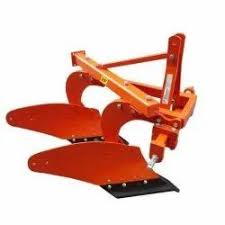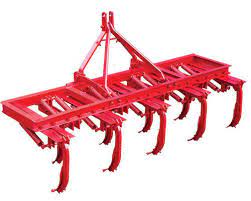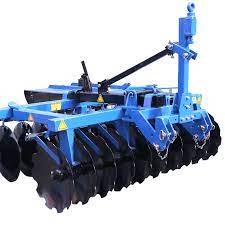Tillage: Influence, Objective & Types
Introduction
Since tilling of soil is preparatory practice in agriculture, tillage is as old as agriculture. Tillage is the agricultural preparation of soil by digging, stirring, and overturning it.
Tillage is the physical manipulation of soil with tools and implements which provide good tilth for better germination and subsequent growth of crops.
Tillage that is deeper and more thorough is classified as primary, and tillage that is shallower and sometimes more selective of location is secondary. Primary tillage such as ploughing tends to produce a rough surface finish, whereas secondary tillage tends to produce a smoother surface finish, such as that required to make a good seedbed for many crops.
Harrowing and rototilling often combine primary and secondary tillage into one operation.
What is tilth?
Tilth indicates two properties of soil viz. the size distribution of aggregates and mellowness or friability of soil. Larger aggregates in higher percentage are necessary for irrigated agriculture while smaller aggregates are desirable for dryland agriculture.
Good tilth means soil is quite porous and has free/drainage up to water table. The capillary and non-capillary pores should be in equal proportion so that enough water and air is retained in the soil.
Mellowness or friability is that property of soil by which the clods when dry become crumblier.
Influence of Tillage on Soil Physical Properties
- Tillage considerably influences soil physical properties like pore space, structure, bulk density, water content and colour. These effects of tillage lost for about a month. Tillage practices have great effect on seed germination, seedling emergence and stand establishment.
- Pore space: Air filled spaces between soil particles constitute pore space. After ploughing these particles are loosely stacked in a random manner as a result pore space is increased.
- Soil structure: When the soil is subjected to tillage at optimum moisture, crumb structure is developed so that loss of soil by erosion is greatly reduced. However, soil structure is destroyed when tillage is carried out at inappropriate soil moisture.
- Bulk Density: Tilling results in loosened soil which increases soil volume without any effect on weight. Therefore, bulk density of tilled soil is less than the untilled soil.
- Soil colour: Tillage increases oxidation and decomposition of organic matter which results in fading of colour.
- Soil water: The amount of available water depends on soil porosity, soil depth and random roughness. All these characters are increased by tillage. Tillage also increases infiltration rate, water holding capacity and hydraulic conductivity.
- Soil temperature: Tillage creates soil temperature optimum for seed germination and seedling establishment. Tillage loosens the soil surface resulting in decrease of thermal conductivity and heat capacity.
Understanding the influence of tillage on soil properties, now it is easier to understand objectives of tillage.
Objectives of Tillage
The primary and most important objectives are:
- Seedbed preparation,
- Weed control,
- Soil and water conservation.
Though, as we seen above the influence of tillage, other objectives include-
- Improvements of soil structure, soil permeability, soil aeration, root penetration,
- Destruction of pests,
- Soil inversion.
Summer deep ploughing improves soil structure due to alternate drying and cooling. Crop residues and FYM are incorporated into the soil by soil inversion action of tillage.
Types of Tillage
Based on time at which tillage are carried out with reference to crop, tillage can be of two types.
Primary Tillage
- Primary tillage is usually conducted after the last harvest, when the soil is wet enough to allow ploughing but also allows good traction.
- The objective of primary tillage is to attain a reasonable depth of soft soil, incorporate crop residues, kill weeds, and to aerate the soil.
- Primary tillage or ploughing is mainly opening of the compacted or hard soil with the help of different plough. Besides, ploughing also ensure inversion (whenever necessary) of soil, uprooting of weeds and stubbles and less cloddy soil surface. Primary tillage loosens the soil and mixes in fertilizer or plant material, resulting in soil with a rough texture. Optimum time for ploughing depends on soil moisture. The optimum range of soil moisture for ploughing is 25-50% depletion of available soil moisture.
- Depth of ploughing depends on the effective root zone depth of the crops. Generally, crops having tap root system require greater depth of ploughing, while fibrous, shallow rooted crops require shallow ploughing.
- Number of ploughings depends on soil type, weed problem and crop residues on the soil surface. Heavy soils require 3-5 ploughings while, light soil require 1-3 ploughings for obtaining proper tilth.
- Type of plough depends on the purpose, soil condition and nature of weed problem. For deep ploughing and inversion, tractor drawn mouldboard plough is used. Disc plough is used for cutting of creeping or spreading grass and inversion while, country plough is used for multipurpose.
Types of Primary Tillage
Based on requirement, deep ploughing, subsoiling, and year-round tillage are carried out.
- Deep Tillage: Deep ploughing of 25-30cm depth is necessary for long duration, deep rooted crops. It also improves soil moisture content. Deep ploughing turns out large sized clods, which are baked by the hot sun when it is done in summer. Summer deep ploughing kills pests due to exposure of pupae to hot sun.
CRIDA, Hyderabad classified ploughing of 5-6cm depth as shallow, 15-20cm depth as medium deep, and 25-30cm depth as deep ploughing. - Subsoiling: It is breaking the hard pan without inversion and with less disturbance of top soil. A narrow cut is made in the topsoil while share of the subsoiler shatters hard pans. chisel plough is also used to break deep hard pans.
- Year-round Tillage: means tillage operations carried out throughout the year. In dry farming areas, repeated tillage operations are carried out until sowing of the crop, even after harvest of the crop, the field is repeatedly ploughed to avoid weed growth in the off season.
- Tied Ridging: Formation of tied ridges in low rainfall areas, enhanced the response to rainfall and fertilizer, the soil supply of plant available N, the positive effect of inter-cropping on total grain yield, and the harvest index.
Primary Tillage Implements
- Ploughs are used for primary tillage. These may be wooden or indigenous, iron or inversion plough and special purpose plough.
- Soil turning ploughs are made of iron and drawn either by bullocks or tractor. These are mouldboard plough, disc plough and reversible or one-way plough.
- Mouldboard ploughs are used where soil inversion is necessary while, disc plough is more suitable for land in which there is much fibrous growth of weeds as the disc cuts and incorporate the weeds. Disc plough works well in soil free from stones.
- Special ploughs are:

Subsoil plough: It is designed to break up hard layer or pans without bringing them to the surface.
Chisel plough: Mainly used for breaking hard pans and for deep ploughing (60-70cm) with less disturbance to the top layers.
Ridge plough: It has two mouldboard and such plough is used to split the field into ridges and furrows and for earthing up of crops.
Rotary plough: It cuts the soil and pulverizes it, suitable for light soils.
Basin lister: It is a heavy implement used to form listed furrows to prevent free runoff of rainfall and blowing off the soil in low rainfall areas.
Secondary Tillage
- These are lighter operations performed after primary tillage.
- Secondary tillageproduces finer soil and sometimes shapes the rows, preparing the seed bed. It also provides weed control throughout the growing season during the maturation of the crop plants, unless such weed control is instead achieved involving herbicides.
- Secondary tillage is any subsequent tillage, to incorporate fertilizers, reduce the soil to a finer tilth, level the surface, or control weeds.
- Harrowing is done to a shallow depth to crush the left clods and to uproot the remaining weeds and stubbles. For these purpose, disc harrow, cultivator, blade harrows etc., are used. The field is made ready for sowing after ploughing by harrowing and planking.
- Generally, sowing operations are also included in secondary tillage.
Layout of seedbed and sowing
After the seedbed preparation, the field is laid out properly for planting seedlings or sowing and irrigation. Flat levelled seedbed is prepared for most of the crops like wheat, soybean, Bajra, groundnut etc. After the secondary tillage, these crops are sown without any land treatments. For crops like maize, vegetables etc., the field has to be laid out into ridges and furrows. Sugarcane is planted in the furrows or trenches. Crops like tobacco, tomato, chilies are planted with equal inter and intra-row space to facilitate two-way inter-cultivation.
After field preparation, sowing is done with seed drills. Sowing is also done by dropping seed behind the country plough.
After Cultivation
The tillage operations carried out in the standing crop are called after tillage. These operations are side dressing of fertilizers, earthing up and inter-cultivation. Earthing up is done to provide extra support against lodging in sugarcane, to provide more soil volume for better growth of tuber in case of potato, and to facilitate irrigation as in vegetables. Inter-cultivation is practiced through blade harrow, rotary hoes etc. in between the crop rows to control weeds.
Secondary Tillage Implements
- Implements like cultivators, harrows, plank, and rollers are used for secondary tillage.
- Tractor drawn cultivator: Cultivator is also known as tiller or tooth harrow. Cultivators are used for finer operations like breaking clods and making soil as fine tilth and can be used to further loosen the previously ploughed land before sowing. It is also used to destroy weeds germinate after ploughing.

- Sweep cultivator: It is useful under stubble-mulch farming where land is prepared to avoid clogging. This cultivator is used to cut up to 12-15cm depth of soil during first operation after harvest and shallower during subsequent operations. It is worked frequently to control weeds and can be used for harvesting groundnut.
- Harrow: Used for shallow cultivation in operations like preparation of seedbed, covering seeds and destroying weeds. It is of two types viz. disc harrow and blade harrow.

- Plank and Roller: when it works most of the clods are crushed due to its weight. Also helps in micro-levelling and slight compaction necessary after sowing. Rollers are used mainly to crush the hard clods and to compact the soil in seed rows.
Frequently Asked Questions (FAQ)
What is reduced tillage?
Reduced tillage leaves between 15 and 30% crop residue cover on the soil or 560 to 1100 kg/ha of small grain residue during the critical erosion period. This may involve the use of a chisel plow, field cultivators, or other implements.
What is Intensive tillage?
Intensive tillage leaves less than 15% crop residue cover or 560 kg/ha of small grain residue. Intensive tillage often involves multiple operations with implements such as a mould board, disk, or chisel plow. After this, a finisher with a harrow, rolling basket, and cutter can be used to prepare the seed bed.
What is Conservation tillage?
Conservation tillage leaves at least 30% of crop residue on the soil surface, or at least 1,100 kg/ha of small grain residue on the surface during the critical soil erosion period. This slows water movement, which reduces the amount of soil erosion. Additionally, conservation tillage has been found to benefit predatory arthropods that can enhance pest control. Conservation tillage also benefits farmers by reducing fuel consumption and soil compaction.
What do you mean by No-till?
Ploughs, disks, etc. are not used. Aims for 100% ground cover.
What is Mulch-till?
Soil is covered with mulch to conserve heat and moisture. 100% soil disturbance.